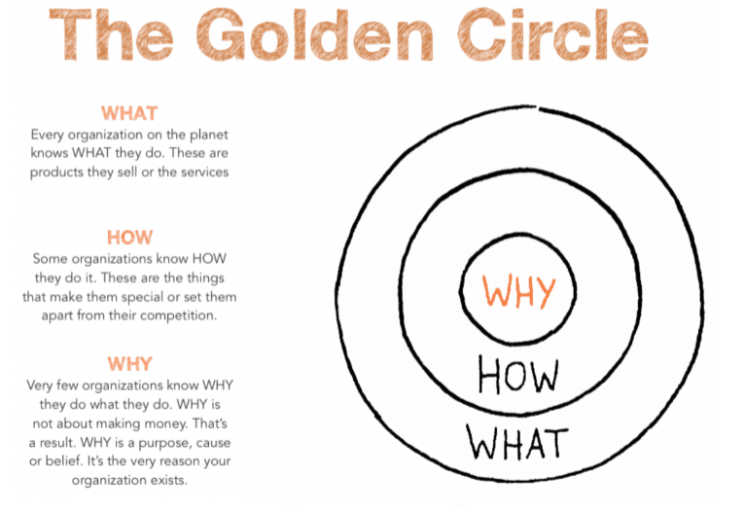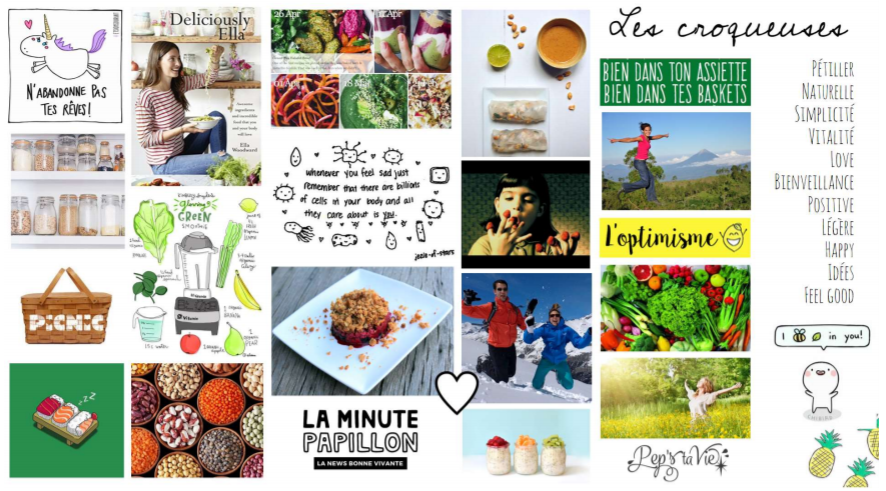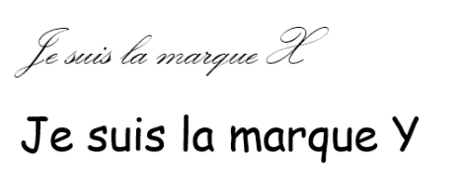Are you looking for new customers? Would you like to be more visible? This is the time to review you communication strategy. The sharper your communication, the better it will connect you with your customers.
We propose three steps to put the basics of your communication in place and ensure that your company is known. Get out a sheet of paper, sit down in a quiet, comfortable and inspiring place and follow the guide.
1. STEP ONE: THE VISION, MISSION AND VALUES
Your vision, mission and values are the reason for being of your company. Together, they define your brand's essence and identity. This is a crucial step for clearly defining your conduct in your business and aligning everyone who joins you in the adventure.
 |
the vision : the "WHY"
Vision defines your ideal, your ultimate goal, your aspirations for the future, and your final destination over the long term. It’s literally the “why” of all of your efforts in your field, which will become your daily source of inspiration and of motivation. How will your company change the world? What is the fundamental issue you want to address? Or, to which positive change will you contribute? To help you, try to complete the following sentences about your business:
- We believe the world will be a better place if...
- We’re putting all our efforts into this project to/because...
- In 5/10/15 years my company will...
A few tips:
- Think BIG: Be daring! Your vision may seem very ambitious, idealistic. That’s what makes it inspiring. Don't worry about “how” at this point.
- Be precise, specific. Avoid vague adjectives that could apply to any number of companies such as “To become the best company”. Think about what makes you unique.
- Simplicity is best. One or two sentences or even a few words should be enough. The clearer and simpler the message, the longer people will remember it.
Here are a few iconic examples to inspire you:
- Airbnb: Wake up at home, anywhere in the world.
- Tesla: To rid the world of the scourge of environmental pollution.
- Ikea: To create a better everyday life for the many people.
the mission : the "WHAT"
Now that your destination is clear, how will you get there safely? The mission defines what you are going to put in place, every day to implement your vision. Here are few questions to ask yourself to clarify your mission:
- What added value do your activities provide?
- What makes you unique; what are your benefits?
- Who are you helping?
Here are a few inspiring examples:
- Airbnb: Provide a service that connects travellers looking for a place to stay with people who have extra room.
- Tesla: Accelerate the global transition to sustainable energies.
- Ikea: Offer a vast selection of aesthetic and functional furnishing products at affordable prices to the largest possible number of people.
the values : the "HOW"
You still have to define the values at the heart of your business. How do you aspire to implement your activities, both within your company and with your partners, suppliers and customers? Values are like little compasses that will provide the framework for your decisions and growth. Your most loyal customers will be those that share the same values. Which is why you have to comply with them no matter what, even it means refusing an interesting opportunity.
how to identify the values that inspire you?
The most logical thing would be to list all the values that you feel are important. However, in this case, you risk creating an endless list of values, which may be noble-minded and beautiful, but which are already commonly accepted, like honesty, sincerity and integrity. Your goal is to find the key values that will make your brand unique. Here are two exercises that will help you:
- Think about some negative experiences you’ve had with a brand, ideally in your industry.
- What did you dislike about the experiences?
-
What is the opposite value you would like to promote?
For example, if you work in the tourism sector, you may have stayed in a charming hotel with pretty, well-decorated rooms but with an enormous amount of waste (everything wrapped in plastic, no sorting, etc.). The opposite value would be respect for the environment. Or, the staff may have seemed to be treated like numbers. In this case, you would promote proximity, a connection with others.
-
Next, ask yourself the following question: if we asked your customers to give the first two or three adjectives that come to mind when they think about your brand, what would you like them to say? To get some ideas, think about some brands you admire and identify the values they represent.
For example, here are the main values promoted by some major companies:
- Ikea: cohesion, caring for people and the planet, cost awareness, simplicity, renewal and improvement, a justified difference, accepting and delegating responsibility, leadership by example.
- Airbnb: safety, honesty, authenticity, reliability
- Innocent: entrepreneurship, responsibility, generosity, sales oriented and natural
Final check : does everything fit together ?
Once your vision, mission and values are defined, it’s important to make sure everything is consistent. Up to you to move from one concept to the next to tune the instruments and strengthen the harmony of you brand identity.
2. SECOND STEP: THE VALUE PROPOSITION AND SLOGAN
The value proposition describes your product or service and the unique value you provide your customers in one or two sentences. It’s also called a Unique Selling Proposition because it has to be unique, appealing and provide an offer (a call to action). It can be very helpful to explain your project in a powerful way in a few words to potential customers, verbally or in writing, for example on your website. It includes:
- Your product: which market segment are you active in? How would your customers describe your product?
- Your target: what is your target audience? What are their problems, their desires?
- Your brand’s promise: your commitment must resonate in your customers’ mind. What unique benefits do you provide your customers? How do you meet their needs?
- How do you differentiate yourself from your competitors: what more do you provide than others? For example: quality, services, ethics, etc.
Note that these questions require some prior preparation if you haven’t already done so in your business plan:
- A market study to identify competitors and their positioning
- Customer interviews to validate your target and precisely identify expectations
- A Business Model Canvas to clarify the basic criteria which will ensure the profitability of your company
- A SWOT analysis, which is an interesting tool to diagnose and identify opportunities in your market
Some examples:
- Airbnb: Discover private rooms or an entire home perfectly suited to all types of travel.
- Tesla: The quickest acceleration. The greatest autonomy. The best charging network.
- Paypal: Simple and secure online payment. This value proposition is found on the Paypal home page with a button underneath which invites visitors to take action and “Sign up for free”.
The slogan (or base line) summarises the company’s value proposition and spirit in a few words. It’s a short, powerful sentence that goes with your logo like a signature. The slogan requires a real creative effort to find a short and original formula that will catch the public’s attention.
- Nespresso, what else?
- Nike: Just do it.
- Quick: Nous, c’est le goût.
3. THIRD STEP: THE VISUAL IDENTITY OR BRANDING
That’s it, your brand has a soul now! Its heart is pounding. Its identity and value proposition are clearly defined. Now you have to dress it up, make it visible, pamper its image to prepare it for its entry into the world. The visual identity expresses the brand identity in an image: the logo, slogan, typography, colours, design, photos...All of these components have an impact on the way the brand is perceived by those who see it.
Idea: bring together all of the images, logos and atmospheres you like in a moodboard (on a PowerPoint slide, for example). This exercise will help you understand the common thread of your communication and can also be very helpful if you work with a graphic artist.

the logo
The logo is the foundation of your brand’s visual identity. It’s the face of your brand, which will be seen everywhere, on all of your communications materials. The challenge is to evoke the values and positioning of the company in a simple way. The logo normally includes the name of the brand and a symbol used either together or separately.
Here are a few tips:
- Keep things simple: avoid using too many colours (maximum two or three), don’t overload the layout (minimalism is great) or use too many different fonts. Less is more!
- Don’t be trendy: a good logo must be unique and durable over the long term.
- Make sure that your logo can be used in all different sizes and in black and white.
You can protect your logo in the Benelux by filing it with the BOIP (Benelux Office for Intellectual Property) at www.boip.int or for a larger area. You may want to wait to reach a certain size before implementing this protection to avoid unnecessary expenses in case your company does not last for some reason.
typography
Never underestimate the importance of typography. It plays an important role in the way people perceive your brand image. Use it consistently on all your communications materials: your website, mailings, etc.
Do this exercise: what do these two fonts evoke for you?

The X brand is finer, more elegant, more refined, more old-school too. It could represent an opera or a dance school because the italics evoke flexibility and movement. The Y brand uses irregular letters and seems less serious and less formal. It evokes youth, fun and humour.
Ask the opinion of people around you to help you validate your final choice!
colours
Colours are a powerful communication tool. Each colour arouses a different emotional response. Blue is often associated with security and trust, whereas red evokes passion and daring. You will tend to use flashier colours to evoke dynamism and pastel colours to reflect calm and equilibrium. Try to select two base colours related to your logo and highlight them in all of your materials.
LAST TIPS FOR THE ROAD
In addition to the logo, topography and colours, it will be up to you to live and anchor your brand identity in everything you do, in all of your communications materials and for centuries to come (at least we hope so for you!). Think about the tone you’re going to use: formal or laid-back, serious or humorous, more traditional or off-beat. Think about your layout and the images you will use, etc. You can also formalise your visual identity in a graphic charter which will dictate precise rules about how the logo must be used and about layout, colours and fonts.
YOU'RE READY. NOW YOU NEED TO GO OUT AND ANNOUNCE THE GOOD NEWS!
Done? Congratulations, you've implemented the main pillars of successful communication! Now, don’t let it all sit around in an old drawer. Let people know about your identity, make a nice poster, make it visible and share it generously with your customers and partners. The best way to accomplish this is with a solid communication plan. And, be sure to live it every day!